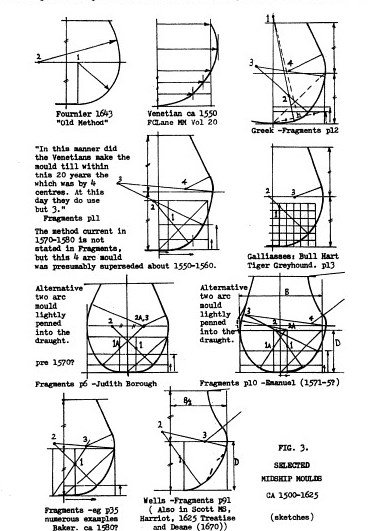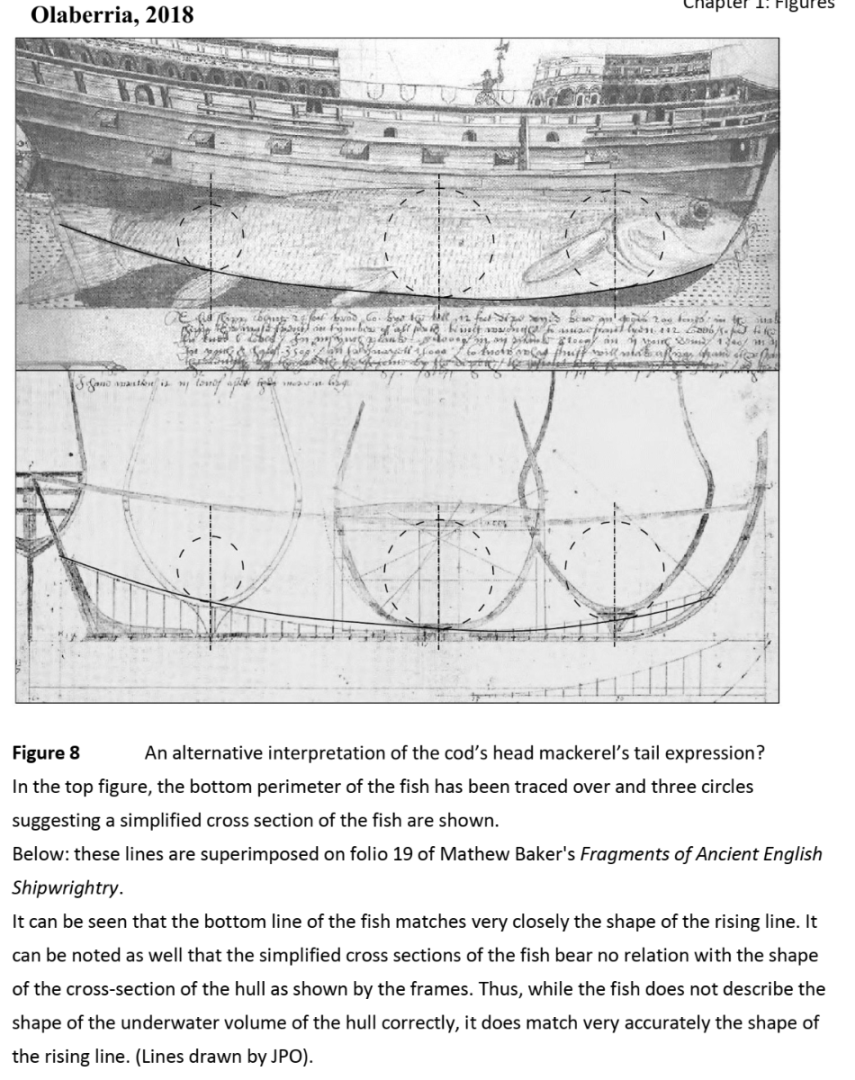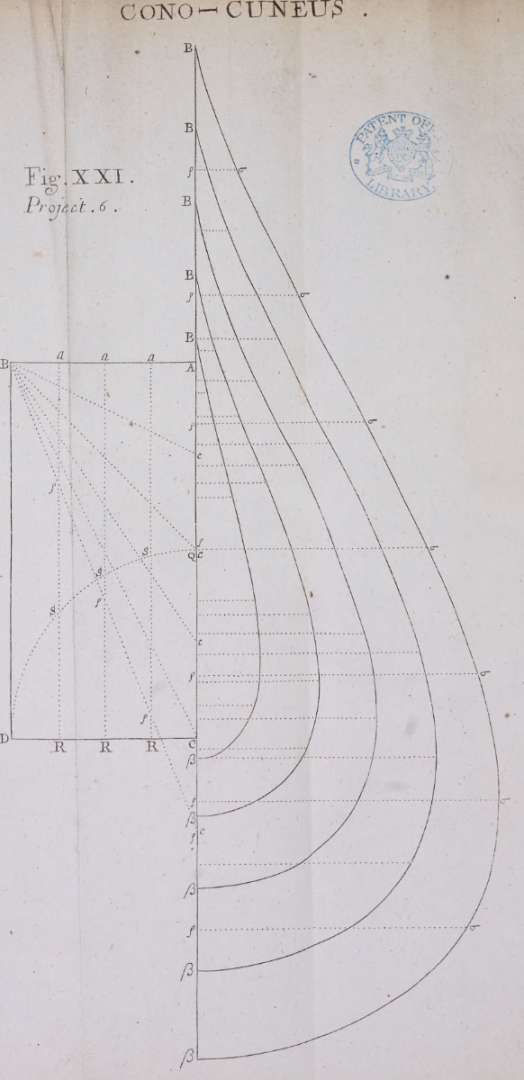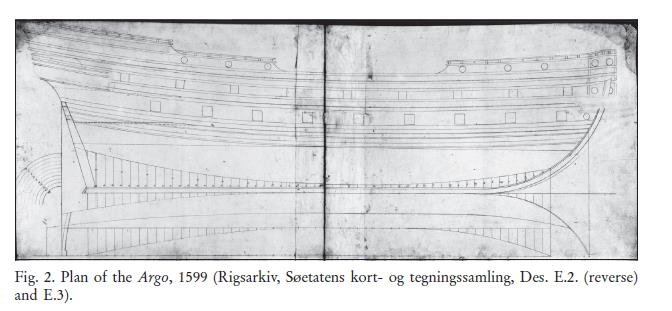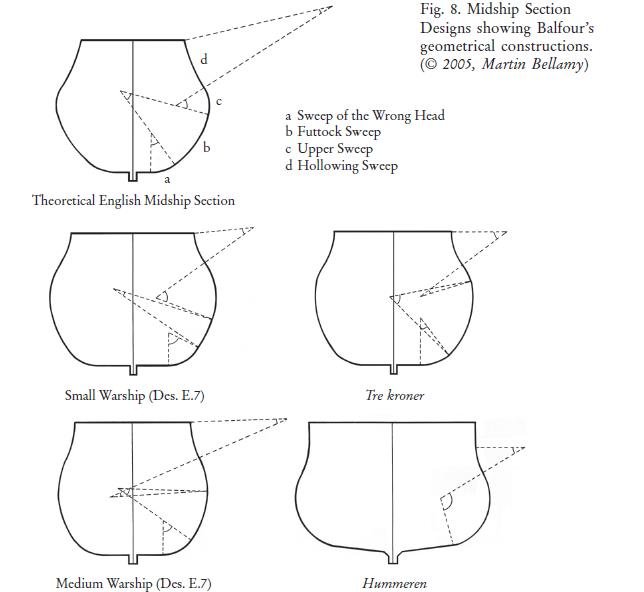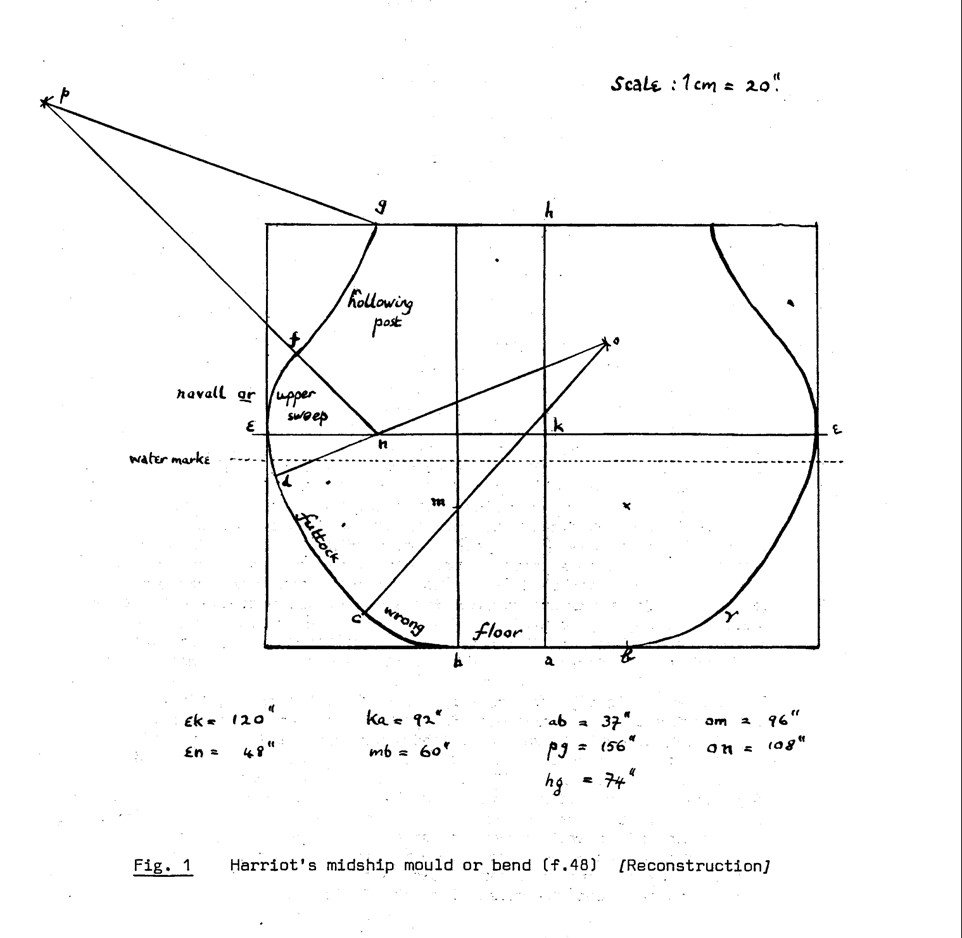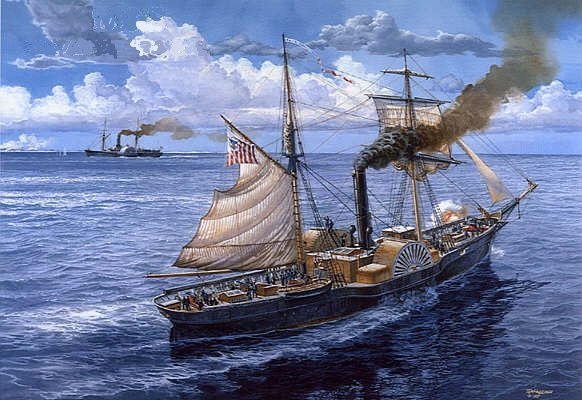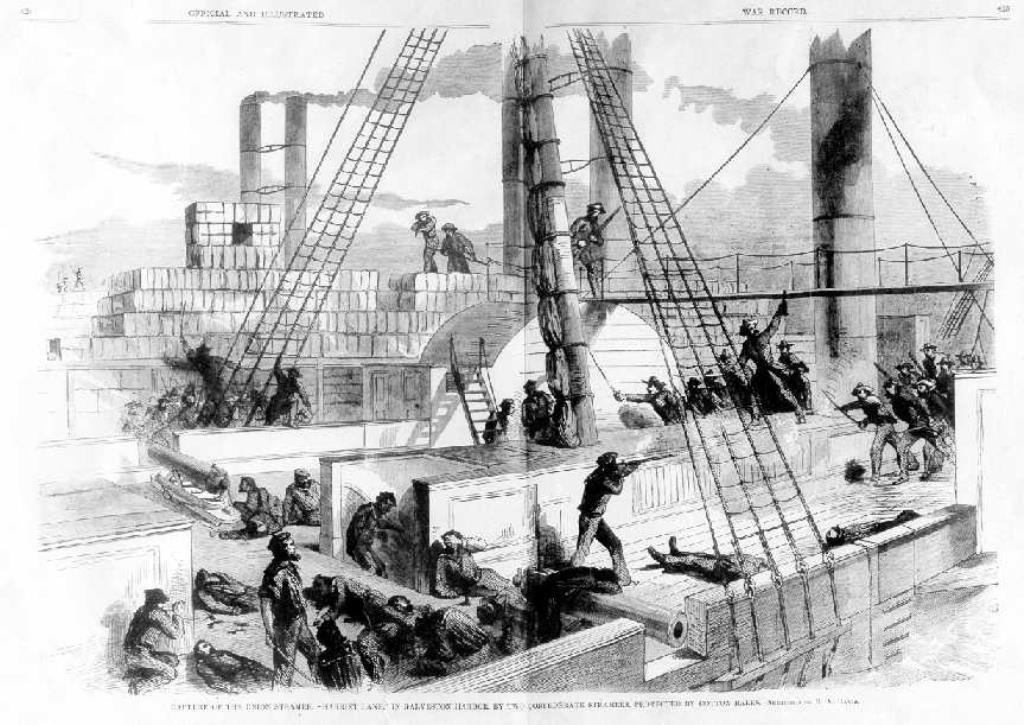-
Posts
3,156 -
Joined
-
Last visited
Content Type
Profiles
Forums
Gallery
Events
Everything posted by trippwj
-

Mathew Baker's early concept of ship hull design, ca. 1570
trippwj replied to Waldemar's topic in Nautical/Naval History
Affirmative. The difference between the early folios in Fragments and the later folios is dramatic. Early folios (including the folio 19 image) are elaborate and watercolored. The later folios are much more technical. See Adams (2013) page 145 as a quick summary, references Barker (1986). Barker has perhaps the most in depth information available on the manuscript that has been published. I have a copy of the full Barker "Fragments" including the footnotes and drawings, but unfortunately neglected to note where I found it! As I recall, I had to take snapshots of each page and paste into a Word document in order to obtain a digital version. In Appendix 2, Adams provides both the transcription from Folio 35 (the midship mould) as well as a somewhat easier to understand modern elaboration. If you are working from Folio 19 (the three moulds superimposed on the sheer draught) the narrative there is greatly simplified. Adams, J. R. 2013. A Maritime Archaeology of Ships: Innovation and Social Change in Late Medieval and Early Modern Europe. 2nd Revised ed. edition. Oxford, UK ; Oakville, CT: Oxbow Books. Barker, Richard. 1986. “Fragments From The Pepysian Library.” Revista Da Universidade de Coimbra XXXII: 161–78. http://home.clara.net/rabarker/Fragments83txt.htm Also see: McGowan, Alan Patrick. 1981. Tiller and Whipstaff: The Development of the Sailing Ship, 1400-1700. H.M. Stationery Office. The figure below is excerpted from Barker. -

Mathew Baker's early concept of ship hull design, ca. 1570
trippwj replied to Waldemar's topic in Nautical/Naval History
No random guesswork concerning the methods. The details are in the text. The elaborate draught is thought to illustrate for the Queen the general design concept rather than define the process. This wasn't a builders draught as such but in some ways analogous to the "Admiralty model" of s slightly later period. -

Mathew Baker's early concept of ship hull design, ca. 1570
trippwj replied to Waldemar's topic in Nautical/Naval History
In Adams' (2013) book he provides a detailed analysis, including reconstructing the lines from Baker, Wells, and Deane for the midship mould. These moulds all have a common characteristic of no deadrise for the flat of the floor (midship mould) - only once the floor sweep is drawn is there any rise. This is most apparent in folio 35 of Baker's Fragments. Also of note is the caveat (often overlooked) that the construction method was not frame built, but rather whole moulding or some variant there of, where the keel and posts were erected, then a few frames installed. The shape was found by ribbands and then initial strakes installed. (Well, paraphrasing greatly that's the process). The importance is that the shipwright did not care too much about the other frames - they were just adjustments to the midship mould based on rising and narrowing lines and measurements of the build in progress! Back to Adams for a moment, he used the proportions and ratios &c. from Fragments to recreate the hull of the wreck Sea Venture as a 3d model. Preliminary results indicate a very stable vessel. His book is well worth the read as one of the most recent syntheses of the topic. -

Mathew Baker's early concept of ship hull design, ca. 1570
trippwj replied to Waldemar's topic in Nautical/Naval History
Here is an interesting figure from Olaberria, Juan Pablo. 2018. “Ship Design-Knowledge in Early Modern Europe: Royal Yachts and the Shared Knowledge of Ship-Designers and Common Shipwrights.” Doctor of Philosophy, University of Southampton. https://www.academia.edu/36363637/Ship_design-knowledge_in_early_modern_Europe_Royal_yachts_and_the_shared_knowledge_of_ship-designers_and_common_shipwrights One of Barker's analyses can be found here - also extensive discussion of Sutherland. Barker, Richard. 2001. “Whole-Moulding: A Preliminary Study of Early English and Other Sources.” In Shipbuilding Practice and Ship Design Methods from the Renaissance to the 18th Century: A Workshop Report, edited by H Nowacki and Matteo Valleriani, Preprint 245, 33–65. [Berlin]: Max-Planck-Institut für Wissenschaftsgeschichte. https://www.mpiwg-berlin.mpg.de/Preprints/P245.PDF. Also see Barker, Richard. 1988. “‘Many May Peruse Us’: Ribbands, Moulds and Models in the Dockyards.” Revista Da Universidade de Coimbra XXXIV: 539–59. Sergio Bellabarba offers an interesting theory concerning early ship design. Bellabarba, Sergio. 1996. “The Origins of the Ancient Methods of Designing Hulls: A Hypothesis.” The Mariner’s Mirror 82 (3): 259–68. https://doi.org/10.1080/00253359.1996.10656602. There are also works by Steffy, Hock, Reith, and Castro that you may find useful. -

Mathew Baker's early concept of ship hull design, ca. 1570
trippwj replied to Waldemar's topic in Nautical/Naval History
See Barker, Olabierra, Bellarba, Ferriero... -

Mathew Baker's early concept of ship hull design, ca. 1570
trippwj replied to Waldemar's topic in Nautical/Naval History
Take a look at some of the works by Richard Barker for some detailed analysis of Baker. Also see the PhD thesis by Olabierra (spp?) for at least one geometric analysis of Baker. -

William Sutherland's concept of ship hull design, 1711
trippwj replied to Waldemar's topic in Nautical/Naval History
Yeah, I feel kind of silly now - I see it listed in the References of your MM article. oops! -

William Sutherland's concept of ship hull design, 1711
trippwj replied to Waldemar's topic in Nautical/Naval History
Druxey - I confess up front to not have the breadth of familiarity that you do concerning the designing of hulls. I noted your comment about Pett and, as I sometimes do, I wandered down a rabbett hole (see what I did there??Rabbett???) and came across a small piece, originally dated 1662, entitled Cono-Cuneus, or, The Shipwright’s Circular Wedge in a letter to the honourable Sir Robert Moray. Since included in Wallis' 1685 A treatise of algebra, both historical and practical The transcribed text of Cono-cuneus may be found here (without figures) Wallis, John. Letter. 1662. “Cono-Cuneus, or, The Shipwright’s Circular Wedge That Is, a Body Resembling in Part a Conus, in Part a Cuneus, Geometrically Considered,” April 7, 1662. http://name.umdl.umich.edu/A67375.0001.001. European Cultural Heritage Online (ECHO) has an on-line version of Treatise of Algebra, including cono-cuneus (with figures) which can be found here (cono-cuneus begins on page 402): Wallis, John. 1685. A Treatise of Algebra, Both Historical and Practical : Shewing the Original, Progress, and Advancement Thereof, from Time to Time, and by What Steps It Hath Attained to the Heighth at Which Now It Is ; with Some Additional Treatises. https://echo.mpiwg-berlin.mpg.de/ECHOdocuView?url=/permanent/library/H3GRV5AU/pageimg&start=421&viewMode=index&pn=430&mode=imagepath. If you desire PDF (I know I do - makes the search and selective printing much easier) then that can be found here (note cono-cuneus starts on page 414, with the figures preceding the text. . Wallis, John. 1685. A Proposal about Printing a Treatise of Algebra, Historical and Practical: Written by Dr. John Wallis. Richard Davis. https://books.google.com/books?id=TXpmAAAAcAAJ. I am not sure if there is direct applicability to the lower form of the hull, but his figures would seem to indicate tha is true. -
Here is the link to the Brown University manuscript: https://bruknow.library.brown.edu/permalink/01BU_INST/9mvq88/alma991016540869706966
- 17 replies
-
- Book
- great britain
-
(and 1 more)
Tagged with:
-

William Sutherland's concept of ship hull design, 1711
trippwj replied to Waldemar's topic in Nautical/Naval History
This has been a most interesting discussion. I do not have the skills to try and replicate the drawings digitally, but have an interest in how these hull forms evolved. Let me offer another couple of references which may (or may not) be of interest to the conversation. Let me introduce David Balfour. According to Bellamy, " One of Christian IV’s principal shipwrights was David Balfour (1574–1634). He was born in St Andrews, Scotland, and we know that he travelled abroad to study mathematics. The first reference to him in Denmark occurs in 1597 when he was awarded contracts to build two galleys. They must have been well received as in 1599 he got his first contract to build a large warship." Why Balfour? Well, there are some archival records of his design process, as well as extant drawings/plans. Below are a couple of images from Bellamy (2006) Source: Bellamy, Martin. 2006. “David Balfour and Early Modern Danish Ship Design.” The Mariner’s Mirror 92 (1): 5–22. https://doi.org/10.1080/00253359.2006.10656978. So we see some use of the design drawing contemporary to the "Newton" manuscript. Of interest for the 17th Century as well may be the 1620-ish Treatise on Shipbuilding as transcribed and annotated by Salisbury in 1958. While this treatise moves us a bit later than the Balfour works, we are still quite a bit behind the era of Sutherland. Here, then, are three more which are available for review. Obviously Deane's Doctrine is the more famous, with a very nice book published by Brian Lavery. THe other two, however, have not been transcribed but may contain some interesting tid bits. Salisbury, William, and R. C Anderson, eds. 1958. A Treatise on Shipbuilding: And a Treatise on Rigging, Written about 1620-1625. Occasional Publication, No. 6. London: Society for Nautical Research. While this treatise moves us a bit later than the Balfour works, we are still quite a bit behind the era of Sutherland. Here, then, are three more which are available for review. Obviously Deane's Doctrine is the more famous, with a very nice book published by Brian Lavery. THe other two, however, have not been transcribed but may contain some interesting tid bits. Battine, Edward. 1685. The Method of Building, Rigging, Apparelling, & Furnishing His Majesties Ships of Warr, According to Their Rates. https://collections.library.yale.edu/catalog/17268860. Bushnell, Edmund. 1678. The Complete Ship-Wright. Plainly ... Teaching the Proportion Used by Experienced Ship-Wrights ... To Which Are Added, Certain Propositions in Geometry ... Also, a Way of Rowing of Ships by Heaving at the Capstane ... The Fourth Edition, Etc. 4th ed. R. W. for William Fisher. https://books.google.com/books?id=kWpnAAAAcAAJ. Deane, Sir Anthony. 1670. “Anthony Deane’s Doctrine of Naval Architecture and Tables of Inventions Etc. - National Maritime Museum.” 1670. http://collections.rmg.co.uk/archive/objects/471544.html. One other set of papers I have not had the opportunity to delve into are those by Thomas Harriott (Manuscript on Shipbuilding and Rigging ca. 1608-1610) Pepper, Jon V. 1981. “Harriot’s Manuscript on Shipbuilding and Rigging (ca. 1608‐1610).” In Five Hundred Years of Nautical Science 1400-1900, edited by Derek Howse, 204–16. National Maritime Museum. https://www.academia.edu/11773314/_III_PEPPER_Jon_V._Harriots_manuscript_on_shipbuilding_and_rigging_ca._1608_1610_. Pepper provides this recreation of lines from Harriot. Website for the collections is “The Manuscripts of Thomas Harriot (1560–1621).” 2012. Digital Edition of Thomas Harriot’s Manuscripts. 2012. http://echo.mpiwg-berlin.mpg.de/content/scientific_revolution/harriot. Also see: Stedall, Jacqueline. 2013. “Notes Made by Thomas Harriot (1560–1621) on Ships and Shipbuilding.” The Mariner’s Mirror 99 (3): 325–27. https://doi.org/10.1080/00253359.2013.815995. At any rate, one final modern study that may be of interest would be the following: Kenchington, Trevor John. 1993. “The Structures of English Wooden Ships: William Sutherland’s Ship, circa 1710.” The Northern Mariner 3 (1): 1–43. Enjoy! Hope some of this is useful in your efforts. -
Mr. Keltridge is elusive! Brown University lists a copy of "His Book", and the RMG Archives show a copy in the R. C. Anderson Collection. RMG also list seven ships plans in the collection, none available online. Unnamed 28-gun and 22-gun Sixth Rates Scale 1:48. A comparative plan depicting the hulls of two unnamed Sixth Rates; one of 87ft 8in length and 28 guns and the other of 70ft length and 22 guns. For each vessel, the plan shows the sheer lines with outboard detail above the waterline, longitudinal half-breadth, sternboard, aft body and fore body. Additionally, there is what appears to be a generic midships section of a Sixth Rate, illustrating the positions of the various decks, pillars and placement of the guns. The latter, in this case, are shown as 12cwt demi-culverins with a barrel length of 6ft. The Keltridge Draughts all carry a very high level of detail, paticularly in relation to the exterior fittings and decoration of the ships depicted. On these vessels, the ornate letters 'I R' can be seen. At first glance, this would seem to suggest vessels that were built or drawn as they appeared during the reign of James II [1685-1688]. However, this is unlikely, given that the Keltridge drawings are supposed to date from the end of Charles II's reign. No explanation for this can be found on the drawings. Adventure (1646) Scale 1:48. A plan with an accompanying table of mast and spar dimensions showing the after body with sternboard, sheer lines with outboard detail above the waterline, fore body and longitudinal half-breadth of the Adventure (1646), a 40 gun Fourth Rate two-decker. The Keltridge Draughts all carry a very high level of detail, paticularly in relation to the exterior fittings and decoration of the ships depicted. On this vessel, the ornate letters 'C R' can be seen, suggesting a vessel that was built or drawn as she appeared during the reign of Charles II [1660-1685]. Unnamed 20-gun Sixth Rates Scale 1:96. A comparative plan depicting the hulls of two unnamed 20 gun Sixth Rates; one of 92ft 6in length and the other of 93ft length. For each vessel, the plan shows the after body with sternboard, sheer lines with outboard detail above the waterline, fore body and longitudinal half-breadth. The Keltridge Draughts all carry a very high level of detail, paticularly in relation to the exterior fittings and decoration of the ships depicted. On this drawing, the vessels are shown with their lower masts in place, each flying a large flag (the usual practice for new vessels when they were launched). The flags depicted include the naval ensign squadron flag [the colour is not specified on the plan], the Royal Standard, the Lord High Admiral's flag, and the 1606 Union flag. Unnamed 103ft, 44-gun Fifth Rate Scale 1:48. A plan showing the sternboard, after body, sheer lines with outboard detail above the waterline, fore body, longitudinal half-breadth and gun deck beams of an unnamed 103ft, 44-gun Fifth Rate. An accompanying table contains a key guide to the various component parts of the illustrated ship. The plan was draughted by William Keltridge. The Keltridge Draughts all carry a very high level of detail, paticularly in relation to the exterior fittings and decoration of the ships depicted. This plan is executed in the same general style, but there are also some notable differences. The ports are illustrated with guns run out, a feature not seen in the other hull lines draughts. The illustration of the profie is a combination of a side elevation with a three-quarter starboard bow perspective (note the lanterns at the stern and the angle at which the frame lines are drawn in green ink). The detail of under-plank framing on the gun deck is also a feature not seen on the other draughts. Various unnamed Rates used for comparative purposes. Scale 1:32. This contents of this sheet are in two distinct parts. To the left is a plan showing the midships section of an unnamed two-decker. The purpose of this drawing appears to be instructional, as the component beams and frames are all named. Accompanying text discusses the calculation of weight and displacement in relation to hull size, shape and capacity. Guns with individual members of their crews are also drawn in, presumeably to scale. The types illustrated are 6 pdrs on the upper deck and 12 pdrs on the gun deck. To the right of this plan is a table of weights showing a breakdown of the total tonnages of equipment and stores required by ships of various Rates. Although no direct reference is made, it is very likely that the ships used as examples in this table are the same ships represented in the other Keltridge drawings. Unnamed 124ft, 46-gun Fourth Rate two-decker Scale 1:48. A plan showing the after body with sternboard, sheer lines with outboard detail above the waterline, fore body and longitudinal half-breadth of an unnamed 124ft 46-gun Fourth Rate two-decker. An accompanying table of armament disposition demonstrates how the number and size of guns carried can be varied. The Keltridge Draughts all carry a very high level of detail, paticularly in relation to the exterior fittings and decoration of the ships depicted. On this vessel, the ornate letters 'C R' can be seen, suggesting a vessel that was built or drawn as she appeared during the reign of Charles II [1660-1685].
- 17 replies
-
- Book
- great britain
-
(and 1 more)
Tagged with:
-
Stock language that the item may be subject to... Again, the copyright would reside in the UK where it was "published". The generic verbiage is on many manuscripts on that site. Sort of a CYA.
- 17 replies
-
- Book
- great britain
-
(and 1 more)
Tagged with:
-
I have only found the one digital version, so can't comment on the different penmanship. There is a copy listed in the R.C.Anderson papers at (I think) the RMG. The various handwriting may reflect having a clerk hand copy it to provide to another "patron". The dedications would be an interesting comparison.
- 17 replies
-
- Book
- great britain
-
(and 1 more)
Tagged with:
-
I somehow doubt that a 337 year old British manuscript is under copyright in the US, but "Fair Use" should protect me!
- 17 replies
-
- Book
- great britain
-
(and 1 more)
Tagged with:
-
After nearly 8 years of occassional search in various archives and libraries for a digital copy, I have finally been able to locate a PDF version of the subject treatise from about 1685 by Edward Battine. For those interested in the evolution of ship building and design this would be a nice addition to the collection. Battine, Edward. 1685. The Method of Building, Rigging, Apparelling, & Furnishing His Majesties Ships of Warr, According to Their Rates. https://collections.library.yale.edu/catalog/17268860. At 60mb the document is a bit too large for me to upload here. Enjoy!
- 17 replies
-
- Book
- great britain
-
(and 1 more)
Tagged with:
-
Goodness, Sam - so many options! In addition to those mentioned above, there are also smaller and less well known venues that have some wonderful examples. In the New England area if the USA we have Mystic Seaport in Connecticut that had some nice models - contemporary, for the most part. The Whaling Museum in New Bedford, Massachusetts has a good mix of whaling related models I have been told (need to get down there some day). At the gateway to Downeast you will find the Penobscot Bay Maritime Museum in Searsport, Maine. They have some nice models though many need conservation. Will find Bluejacket Model Ships just a few hundred meters up the road, where some beautiful modern models are (or at least used to be) on display. If'n you make it way Downeast I'll treat to a lobstah feed after you visit the Tide's Institute to view the small collection there (focus on Eastport shipbuilders and the sardine fishery). Wow - you could have a really fun trip through the Northeast!
-

Historical Teachers of the Modeling Craft: Davis vs Underhill
trippwj replied to SaltyNinja's topic in Nautical/Naval History
They are both very useful for the techniques of building a model - the process is applicable beyond the specific vessels they built. -

A critique of the works of Nicolaes Witsen
trippwj replied to Philemon1948's topic in Nautical/Naval History
I have finally had an opportunity to sit myself down and look through this topic with a more critical eye and resources that I have compiled at hand. I must appologize, sir, for a couple of prior posts. It is now apparent to me that you are indeed intimately familiar with at least one of the researchers I suggested earlier. As I was preparing a reply I realized that I had seen something quite similar - and then it struck me. I have followed your chapters on Academia for some time, and the Pitch on a topic concerning Cornelis van Yk and Nicolaes Witsen document finally provided me with enough wattage to illuminate my decidedly dim light (that is to say, the light bulb went off). It is apparent that you have invested many years and much effort into developing your thesis. I wish I had more to offer other than possible resouces that I occassionally stumble across in the archeological record, Best of luck with this, and keep pushing onward - Kind Regards, -

A critique of the works of Nicolaes Witsen
trippwj replied to Philemon1948's topic in Nautical/Naval History
There is some potentially useful information to be found in the modern academic publications. While it is true there are no deep dive comparisons of Witsen and Yk,the two also represent the end of one construction style and the advent of another. See the preface in Hoving for a brief overview. It is an interesting topic, but I doubt that it would warrant a book length publication but, perhaps, something in one of several journals. -
In many a fire station over the years a version of the "in/out" board has been used. For each piece of apparatus there are various riding positions, each of which brings specific initial fire ground responsibilities. The name of the individual assigned each position was placed next to the position for accountability purposes. As an example, an Engine may have 4 positions and you would find: Officer - LT Smith Engineer/Driver - FF Jones Nozzle - FF Spray Hydrant - FF Giardelli
-
I started model building as an uninformed newbie who bought my first kit on a whim. It remains mostly built (I found tying ratlines at 1:128 more tedious than I had thought possible). I have 2 more partially built but both have fatal flaws from the early stages that I have been unable to overcome. What does that have to do with this topic? While trying to find references to aid in my very steep learning curve, I began to acquire books. First of the how-to variety, then more historical. When the NRG had the big sale I acquired several dozen (I think it was around 60?) on various topics. I now have more than 300 print volumes in my collection - some much more frequently used than others, but all at least partly read. Surprisingly only about 8 or 10 works of fiction. This desire for information and clarification spurred my hobby of collecting (and building a searchable database) older pdf treatises and publications, tgen broadening to modern pdf documents (such as dissertations and theses, journal articles and so on). That collection now numbers more than 2,500 documents. Someday, I hope to update the work by Anderson, Takakjian and McDonald with additions from the internet era. I will never approach, however, the volume of information in Albion or Rasor. The answer to which are the best is highly subjective and unique to an individual. Subjects of interest, specific vessels or types, time frames or nations all influence the decision. As but one example, I find myself referring often ti "Ships and Science" by Ferreiro concerning many aspects of naval architecture, while the Naval Documents for different eras published by the Navy History Command are invaluable for early US Navy information - tough to argue with transcribed source documents!
-
For those so inclined to delve into the older methods of gauging the contents, here are a few contemporary resources that you may (or may not) find of interest. Hunt, William, and Richard Walker. 1687. The Gaugers Magazine: Wherein the Foundation of His Art Is Briefly Explain’d and Illustrated with Such Figures, as May Render the Whole Intelligible to a Mean Capacity. Printed by Mary Clark for the author. https://books.google.com/books?id=y_FZAAAAcAAJ Leadbetter, Charles. 1755. The Royal Gauger; Or, Gauging Made Perfectly Easy ... The Fourth Edition, Very Much Enlarged and Improved, Etc. E. Wicksteed. https://books.google.com/books?id=zFJiAAAAcAAJ Thomas Everard. 1721. Stereometry, or, the Art of Gauging Made Easie ... The Fifth Edition ... Corrected, Etc. https://books.google.com/books?id=y_FZAAAAcAAJ Turner, Mr. 1761. The Young Gauger’s Best Instructor: Being a New and Complete System of Gauging in All Its Varieties, Both Theory and Practice. Exhibiting, I. Decimal Arithmetick. II. The Extraction of the Square and Cube Roots. III. The Calculations of All Kinds of Multipliers, Divisors, and Gauge-Points. IV. The Methods of Finding the Areas and Contents, of All Sorts of Superficies and Solids, in Ale, Beer, Wine, Cyder, Perry, Starch, Tallow, Soap, &c. V. Rules for Gauging, Inching, and Ullaging, of All Manner of Tuns, Tubs, Cisterns, Coolers, Coppers, Stills, and Casks. VI. The Methods of Computing the Excise of Any Number of Hogsheads, Barrels, and Bushels, of Ale, Beer, Cyder, Malt, &c. VII. The Description and Use of the Gauging-Rule and Gauging-Rod. VIII. The Scheme of a Division and Dimension-Book; and Specimens of Vouchers, and Abstracts. With Many Other Useful and Necessary Improvements, in a Much More Easy, Familiar, and Expeditious Method, Than Any Yet Published. The Whole Being So Calculated, as to Render It Not Only Serviceable to Experinced [Sic] Officers; But Likewise of the Greatest Use to All, Whose Business It Is to Instruct Others, Or Who Intend to Qualify Themselves for Employmets [Sic] in the Revenues of Excise. B. Law and Company in Avemary-Lane.https://books.google.com/books?id=rZbzZ8H7YhgC Enjoy!
About us
Modelshipworld - Advancing Ship Modeling through Research
SSL Secured
Your security is important for us so this Website is SSL-Secured
NRG Mailing Address
Nautical Research Guild
237 South Lincoln Street
Westmont IL, 60559-1917
Model Ship World ® and the MSW logo are Registered Trademarks, and belong to the Nautical Research Guild (United States Patent and Trademark Office: No. 6,929,264 & No. 6,929,274, registered Dec. 20, 2022)
Helpful Links
About the NRG
If you enjoy building ship models that are historically accurate as well as beautiful, then The Nautical Research Guild (NRG) is just right for you.
The Guild is a non-profit educational organization whose mission is to “Advance Ship Modeling Through Research”. We provide support to our members in their efforts to raise the quality of their model ships.
The Nautical Research Guild has published our world-renowned quarterly magazine, The Nautical Research Journal, since 1955. The pages of the Journal are full of articles by accomplished ship modelers who show you how they create those exquisite details on their models, and by maritime historians who show you the correct details to build. The Journal is available in both print and digital editions. Go to the NRG web site (www.thenrg.org) to download a complimentary digital copy of the Journal. The NRG also publishes plan sets, books and compilations of back issues of the Journal and the former Ships in Scale and Model Ship Builder magazines.


